This document discusses employee grievances and industrial disputes in India. It defines an employee grievance as a complaint raised by a worker against their employer. Common causes of grievances include issues related to compensation, work conditions, supervision and organizational changes. The document outlines the processes of conciliation, arbitration and adjudication used to resolve grievances and maintain discipline in industries. It also examines the meaning and causes of industrial disputes and how prevention and settlement of disputes is approached in India through mechanisms like standing orders, codes of discipline, and conciliation boards.
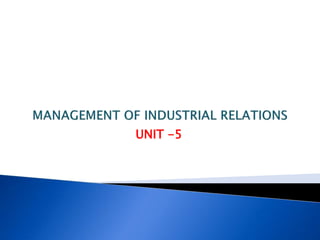






![ Standing Orders’ Means Rules Of Conduct For Workmen Employed In
Industrial Establishments. ‘Standing Orders’ Means Rules Relating To
Matters Set Out In The Schedule To The Act. [Section 2(G)].
The Schedule To The Act Requires That Following Should Be Specified In
Standing Orders –
(A) Classification Of Workmen I.E. Temporary, Badli, Casual, Permanent, Skilled Etc.
(B) Manner Of Intimating To Workmen Working Hours, Shift Working, Transfers Etc.
(C) Holidays
(D) Attendance And Late Coming Rules
(E) Leave Rules (F) Leave Eligibility And Leave Conditions
(G) Closing And Reopening Of Sections Of Industrial Establishment
(H) Termination Of Employment, Suspension, Dismissal Etc. For Misconduct And Acts
Or Omissions Which Constitute Misconduct
(I) Retirement Age
(J) Means Of Redressal Of Workmen Against Unfair Treatment Or Wrongful Exactions
By Employer
(K) Any Other Matter That May Be Prescribed.](https://image.slidesharecdn.com/unit-5-151124092742-lva1-app6892/85/Unit-5-8-320.jpg)







![ The appropriate Government is empowered to appoint any
number of persons, as it thinks fit, to be conciliation
officers. The conciliation officer having duty of mediating
and acts as the mediators in between the parties to resolve
the dispute.
In the case of public utility services matters like strikes
and lockouts the conciliation officer can initiate the
conciliation proceeding ad tries to settle the dispute in
between the parties.
If the conciliation officer fails to resolve the dispute
between the parties, he should report to the appropriate
government. If necessary the dispute shall be referred to
the Board, Labour Court, Tribunal or National Tribunal, by
the appropriate government. [Sec 12 (5)]](https://image.slidesharecdn.com/unit-5-151124092742-lva1-app6892/85/Unit-5-16-320.jpg)
![ According to [Sec 10 (2)] when parties in the industrial dispute apply to
the government to refer dispute to the Conciliation Board and if
government satisfies it shall make the reference to the Conciliation
Board.
Duties of board. [Sec 13]
it shall be the duty of the Board to endeavor to bring about a settlement
of dispute.
Investigate the matters relating to the dispute between parties and
inducing the parties to come to a fair and amicable settlement of the
dispute.
In case of failure of settlement of dispute in between parties, duty to
send to the government the report of facts and circumstances relating to
the disputes and board opinion, a settlement could not be arrived at,
The Board shall submit its report under this section within 2 months of
the date on which the dispute was referred to it or within such shorter
period as may be fixed by the appropriate Government.
](https://image.slidesharecdn.com/unit-5-151124092742-lva1-app6892/85/Unit-5-17-320.jpg)


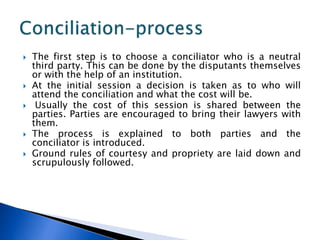








![ Independence and impartiality [Section 67(1)]
Fairness and justice[Section 67(2)]
Confidentiality [Section 70]
Disclosure of the information[Section 70]
Co-operation of the parties with Conciliator
[Section. 71]](https://image.slidesharecdn.com/unit-5-151124092742-lva1-app6892/85/Unit-5-29-320.jpg)
![ Commencement of the conciliation
proceedings [Section 62
Submission of Statement to Conciliator
[Section 65]
Conduct of Conciliation Proceedings[Section
69(1),67(3)]-
Administrative assistance [S. 68]-](https://image.slidesharecdn.com/unit-5-151124092742-lva1-app6892/85/Unit-5-30-320.jpg)







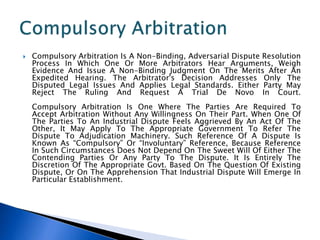






![ Labour Court [Sec. 7]: The appropriate
Government is empowered to constitute one
or more Labour Courts. Its function is the
adjudication of industrial disputes relating to
any matter specified in the Second Schedule.](https://image.slidesharecdn.com/unit-5-151124092742-lva1-app6892/85/Unit-5-45-320.jpg)
![ SECOND SCHEDULE
The propriety or legality of an order passed by an employer under the
standing orders;
The application and interpretation of standing orders;
Discharge or dismissal of workmen including reinstatement of, or grant
of relief to, workmen wrongfully dismissed;
Withdrawal of any customary concession or privilege;
Illegality or otherwise of a strike or lock-out; and
According to [Sec 10 (1) (c)] matters specified in THIRD SCHEDULE,
dispute not effecting more than 100 workers can be referred to labour
court.
According to [Sec 10 (2)] when parties in the industrial dispute apply to
the government to refer dispute to the labour court and if government
satisfies it shall make the reference to the labour courts.
According to [Sec 10 (6)] no Labour Court or Tribunal shall have
jurisdiction to adjudicate upon any matter which is under adjudication
before the National Tribunal.](https://image.slidesharecdn.com/unit-5-151124092742-lva1-app6892/85/Unit-5-46-320.jpg)
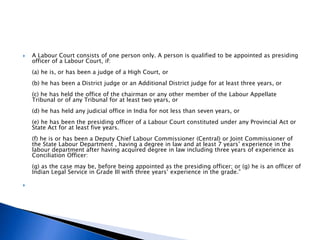
![ Industrial Tribunal [Sec. 7A]: The appropriate
Government may, by notification in the
Official Gazette, constitute one or more
Industrial Tribunals for the adjudication of
industrial disputes relating to any matter,
whether specified in the Second Schedule or
the Third Schedule and for performing such
other functions as may be assigned to them
under this Act.](https://image.slidesharecdn.com/unit-5-151124092742-lva1-app6892/85/Unit-5-48-320.jpg)

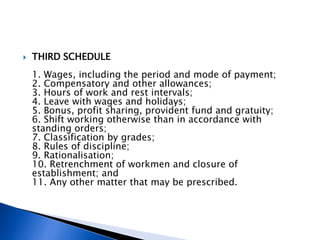
![ According to [Sec 10 (2)] when parties in the
industrial dispute apply to the government to
refer dispute to the industrial tribunal and if
government satisfies it shall make the
reference to the industrial tribunal.
According to [Sec 10 (6)] no Labour Court or
Tribunal shall have jurisdiction to adjudicate
upon any matter which is under adjudication
before the National Tribunal.](https://image.slidesharecdn.com/unit-5-151124092742-lva1-app6892/85/Unit-5-51-320.jpg)

![ National Tribunal [Sec. 7 (B)]: The Central Government may, by
notification in the Official Gazette, constitute one or more
National Industrial Tribunals. Its main function is the
adjudication of industrial disputes which involve questions of
national importance or affecting the interest of two or more
States.
According to [Sec 10 (1-A)] dispute involves any question of
national importance or is of such a nature that industrial
establishments situated in more than one State, whether it
relates to any matter specified in the Second Schedule or the
Third Schedule, the government will order in writing refer to
National Tribunal for adjudication.
According to [Sec 10 (2)] when parties in the industrial dispute
apply to the government to refer dispute to the National Tribunal
and if government satisfies it shall make the reference to the
National Tribunal.](https://image.slidesharecdn.com/unit-5-151124092742-lva1-app6892/85/Unit-5-53-320.jpg)

![ Voluntary reference of disputes to arbitration. [sec. 10 (a)]: an
arbitrator is appointed by the Government. Whether the dispute
is before Labour Court, or Industrial Tribunal or National
Tribunal, the parties can go to arbitration by written agreement.
The arbitrators conduct the investigation in to the dispute
matters and give arbitration award (final decision or settlement
or decree) as for making reference of an industrial dispute. If an
industrial dispute exists or is apprehended and the employer and
the workman agree to refer the dispute to an arbitration, they
may refer the dispute to an arbitration. But such reference shall
be made before the dispute has been referred under Sec. 19 to a
Labour Court or Tribunal or National Tribunal by a written
agreement. The arbitrator may be appointed singly or more than
one in number. The arbitrator or arbitrators shall investigate the
dispute and submit to the appropriate Government the
arbitration award signed by the arbitrator or all the arbitrators,
as the case may be.](https://image.slidesharecdn.com/unit-5-151124092742-lva1-app6892/85/Unit-5-55-320.jpg)









